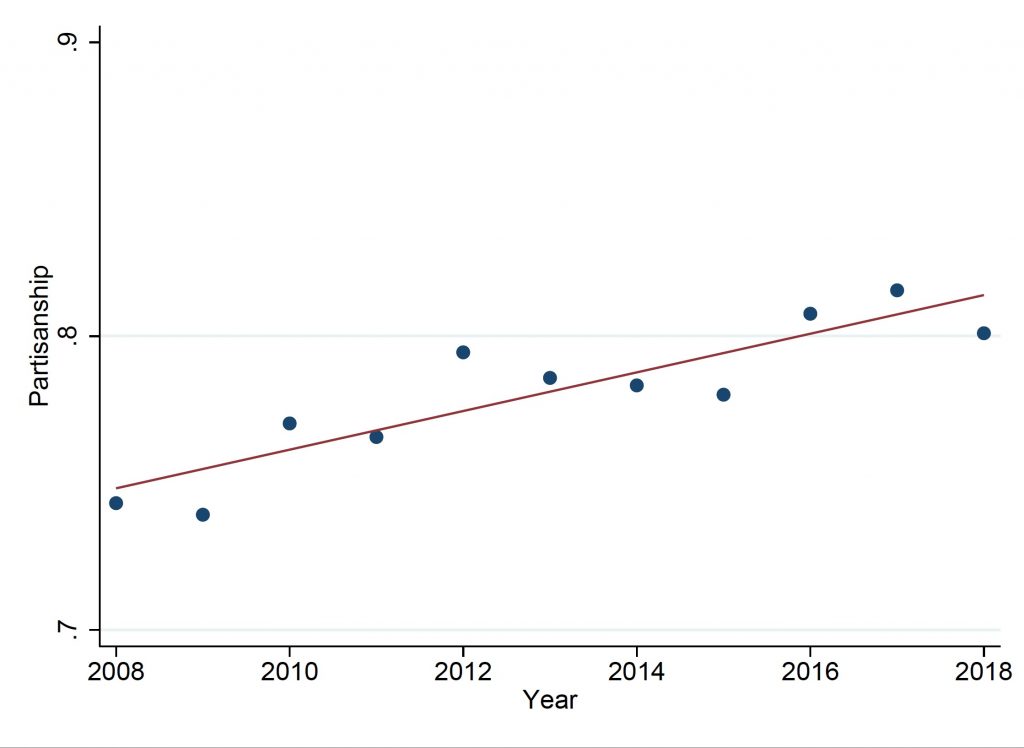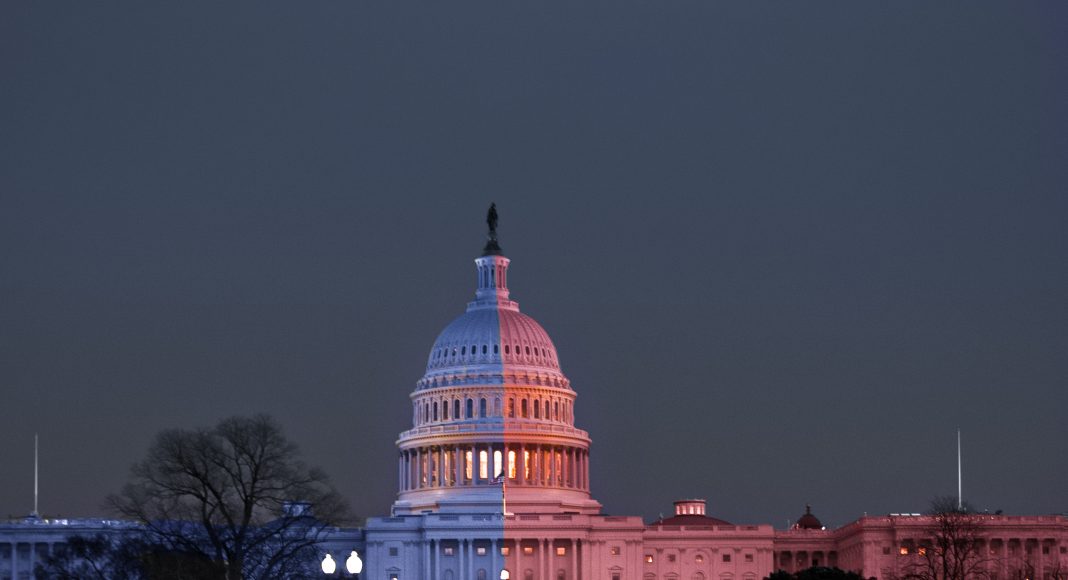A new paper examines political polarization among top executives in S&P 1500 firms, highlighting a robust trend toward political polarization in corporate America. This trend implies that the growing tendency of US individuals to socialize and form relationships and friendships with politically like-minded individuals also extends to C-level executives in large, public US companies.
The United States is increasingly divided along partisan lines. A Pew Research Center survey shows that party identification is now a more significant predictor of Americans’ fundamental political values than any other social or demographic divide. Moreover, social groups—most notably families—have become more politically homogeneous, as individuals prefer to form relationships with politically like-minded individuals.
In contrast, the workplace has long been considered the social context best positioned to provide opportunities for regular interactions and conversations across partisan lines. Yet, we have a limited understanding of the degree of political polarization in the workplace and how it has changed over time.
In our new paper, we study political polarization among important decision-makers in the firm: top executives. We think it is important to study political polarization among executive teams for two main reasons. First, corporate executives are responsible for designing and executing the most important corporate decisions, and they have a substantial influence on the firm’s managerial ranks via promotion and hiring decisions. Second, there is a growing body of evidence showing that partisanship influences economic thinking and economic decisions not only by households, but also by economically sophisticated agents in high-stakes environments. In light of these individual-level biases, a more politically homogenous work environment is cause for concern because it implies that decisions are increasingly made in partisan bubbles.
Data
To study this question, we combine data on the top five earning executives in US S&P 1500 firms with information on party affiliations from voter registration records. We use voter registration records from California, Colorado, Illinois, Massachusetts, North Carolina, New Jersey, New York, Ohio, and Texas, spanning the period from 2008 to 2018. We restrict our sample to these locations because other states either do not share voter registration records or do not track voters’ party affiliations over time.
We find that US executives are predominantly Republican. Among executives that we can link to a political party in the voter records, 69 percent are Republicans and 31 percent are Democrats. The share of Republican executives is substantially higher in the voter registration data compared to the political contributions data, as many executives donate to both parties. Moreover, there has been an increase in the share of Republican executives during our sample period, from 63 percent in 2008 to 71 percent in 2018. This trend contrasts with the common perception that US executives have become more outspoken on progressive issues.
The Partisanship of Executive Teams
We define the partisanship of an executive team as the degree to which political views within the same team are dominated by a single party. More specifically, we measure the partisanship of executive teams as the probability that two randomly drawn executives from the same team would be affiliated with the same political party. The partisanship of the average executive team in our sample is equal to 78 percent. This level of partisanship is substantially higher than the degree of political alignment between executives and other individuals living in their zip code (67 percent), and it is almost as high as the degree of political alignment between executives and their spouses (80 percent).
More importantly, we find a 6.6 percentage-point increase in the average partisanship of executive teams over our sample period (see Figure 1). The years with the highest annual increases in partisanship are 2010, 2012, and 2016—that is, around presidential elections and the passage of the controversial Affordable Care Act (“Obamacare”).

We can rule out the possibility that the increase in partisanship reflects strategic behavior on behalf of the executives to appear more politically aligned with their peers. For example, we obtain the same result if we use the party affiliation of the executive’s spouse or of the majority of voters in the executive’s zip code, rather than that the executive’s own party affiliation.
What drives the increase in the political polarization of executive teams? One possibility is that the increase in partisanship reflects changes in the share of Republicans and Democrats within the overall population of executives. Alternatively, the increase in partisanship could result from an increased tendency of executives to sort into firms with like-minded partisans. To separate the two channels, we perform simulations in which we randomly assign each executive a party affiliation, using the share of Republican and Democratic executives in a given year as inputs. We can then compare the actual degree of partisanship in our data to the degree of partisanship we would expect if executives sorted into firms randomly. Following this approach, we document that 61 percent of the increase in partisanship is driven by an increased tendency of executives to match with other executives who share their political views. The remaining 39 percent is driven by the executive population as a whole becoming more politically homogeneous (i.e., Republican).
Further, we find that a substantial part of the effect is driven by increased sorting on the basis of political ideology into states and industries (e.g., a declining share of Republican executives in California and a rising share of Republican executives in Texas). Individuals changing their party affiliation play a minor role.
Executive Departures
We also study the role of political views in shaping team formation at a more granular level. Specifically, we test whether political alignment with other team members influences executives’ decision to leave the firm. We find that, within the same firm and year, executives who are politically aligned with the majority of the team have a 3.2-percentage-points-lower probability of leaving the firm, relative to executives whose views are not aligned with the rest of the team. This effect corresponds to a 24.6 percent decrease in the likelihood of departure.
We again observe a strong increase in the effect over time: during the period 2008–2014, the effect is relatively small and statistically insignificant. However, it becomes highly economically and statistically significant during the last years of our sample period (2015–2017), which were marked by particularly high levels of polarization.
The rising partisanship of executive teams is even more remarkable in light of recent trends in other dimensions of diversity. For example, executive teams have become more diverse in terms of gender and race over the same time period. Because female and minority executives are more likely to be Democrats, controlling for diversity along the gender and race dimensions tends to further increase our estimate of the increase in partisanship.
Heterogeneity
Finally, in order to better understand potential drivers of the rise in polarization, we explore how the increase in executive sorting depends on the legal environment, shareholders, and consumers.
Although there is no federal law prohibiting discrimination based on political ideology by private employers in the United States, some states have adopted laws prohibiting such discrimination—the states from our sample that currently have such laws in place are California, Colorado, Illinois, Massachusetts, New York, and Ohio. We conjecture that if a firm is headquartered in states with a law that prohibits workplace discrimination based on political ideology, the trend in partisanship of executive teams should be weaker. Consistent with this hypothesis, we find that firms located in states with such anti-discrimination laws do not exhibit an increase in partisanship. Instead, we find that the trend is driven by states that have not adopted such laws. These results suggest that state laws could potentially play a role in mitigating the increased sorting of executives based on political views.
Next, we consider two important types of stakeholders: shareholders and customers. We find that the increased sorting of executives is less pronounced in firms with a high level of institutional ownership and in customer-oriented industries (e.g., food, household durables, hotels). The result regarding the role of institutional ownership in mitigating partisanship of political views in executive teams is consistent with institutional investors often emphasizing the importance of diversity in the workplace. The fact that executives in consumer-oriented industries do not exhibit a rising tendency to sort on the basis of political affiliation suggests it is unlikely that the rising partisanship in executives’ political views is driven by a rising polarization among their customer base.
“An important question raised by our findings is to what extent does the growing partisanship in C-suites lead to distorted decision making within firms.”
Conclusion
Overall, our paper highlights a robust trend toward political polarization in corporate America. This trend implies that the growing tendency of US individuals to socialize and form relationships and friendships with politically like-minded individuals also extends to C-level executives in large, public US companies.
An important question raised by our findings is to what extent does the growing partisanship in C-suites lead to distorted decision making within firms. On the one hand, if a partisan workplace exacerbates individual partisan biases, then the trend towards increased partisanship among executive teams could distort firms’ investment and financing policies, as well as their decision-making when it comes to hiring and promotions. On the other hand, more politically homogeneous teams could be desirable if political alignment improves trust and collaboration among team members. We look forward to future research exploring those issues.
References
Bertrand, Marianne, and Antoinette Schoar, 2003, Managing with style: The effect of managers on firm policies, Quarterly Journal of Economics 118, 1169-1208.
Dagostino, Ramona, Janet Gao, and Pengfei Ma, 2021, Partisanship in loan pricing, Working Paper.
Gormley, Todd A., Mahsa Kaviani, and Hosein Maleki, 2021, Are judges like umpires? Political affiliation and corporate prosecutions, Working Paper.
Hertel-Fernandez, Alexander, 2020, Power and politics in the U.S. workplace, Economic Policy Institute.
Iyengar, Shanto, Tobias Konitzer, and Kent Tedin, 2018, The home as a political fortress: Family agreement in an era of polarization, Journal of Politics 80, 1326-1338.
Kempf, Elisabeth, and Margarita Tsoutsoura, 2021, Partisan professionals: Evidence from credit rating analysts, Journal of Finance 76, 2805-2856.
Mutz, Diana C., and Jeffery J. Mondak, 2006, The workplace as a context for cross-cutting political discourse, Journal of Politics 68, 140-155.
Pew Research Center, 2017, Key takeaways on Americans’ growing partisan divide over political values, Author: Carroll Doherty.
Learn more about our disclosure policy here.






